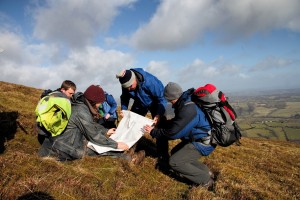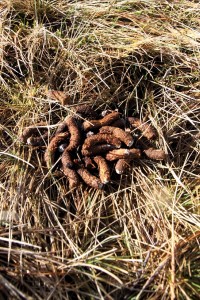This month marks the start of an exciting period for National Park Wardens, ecologists and volunteers as they gather together to record the numbers of red grouse in the heather uplands of Bannau Brycheiniog National Park.
Earlier this month, nearly 30 conservationists including National Park wardens, ecologists, volunteers and trainee Wardens joined forces to organise four grouse counts in the areas of Y Mynydd Ddu, Drysgol, and on northern and southern sections of Hatterrall Hill marking the start of the National Park’s first red grouse survey counts for the year.
During the survey, conservationists look for actual sightings, but also track the location of droppings and any other signs of grouse they might see. They also record evidence of other birds such as golden plover, snipe, ravens, merlins and goshawks. These signs give an indication of where the birds might be pairing in the spring and setting up territories. Spring counts tell conservationists how many grouse survived the winter. Later in the year the numbers indicate how successfully the grouse are reproducing. Early findings from the survey counts suggest that the red grouse population is maintaining its numbers although it’s still too early to tell whether the population has grown since last year’s count. The next grouse count will be held on Hatterrall Hill in the coming weeks and the next one in late June-early July 2015. We hope that at the end of the summer surveys, results will indicate the red grouse have responded well to the active upland management of heather and the peat bog restoration.

Red grouse declined in previous years due to the loss of their natural, heathland and peatland habitats. Changes to land use including increasing commercial forestry and recreation, fluctuating livestock numbers with loss of traditional upland grazing practices, poor burning practices and even uncontrolled burns, climate changes and the loss of active heather and peatbog management are all factors which have led to a decline in this and other species over the years. Red grouse also have to contend with natural predators like foxes, crows, stoats, weasels, and birds of prey including hen harriers. Protecting the fragile upland heather habitats and maintaining healthy grazing patterns plays a significant role in their future survival. Research has shown that red grouse are a good indicator species, and conservationists can use any changes in their fortunes to understand the condition of upland heather moorland habitats. The red grouse and their chicks are directly dependent on the plants that grow there for shelter and as a food source.
Bradley Welch, Senior Ecologist for Bannau Brycheiniog National Park Authority said: “Grouse and heather moorland are key features of the Black Mountains Site of Special Scientific Interest (SSSI). We work in co-operation with local landowners to ensure that we maintain the grouse population and habitat in appropriate condition to continue encouraging future generations thrive. As this species and associated habitat are on the southern edge of the geographic distribution, their status and condition may also tell us something about the effects of climate change.
“Red grouse need heather at different stages of its life cycle—older heather for cover and younger heather for food. Our upland management programme requires varying degrees of cutting, burning and grazing on roughly a 20-year rotation to maintain the mosaic of habitat conditions needed to improve the moorland for the red grouse. Other upland ground nesting birds benefit from this management, so the numbers of grouse will give us an indication of the status of other species without having to count all the different birds in the area. We hope that over time we will see a steady improvement in some of the key wildlife characteristics and habitats of these uplands, indicted by an increase in grouse numbers.”

Mrs Margaret Underwood, Biodiversity Champion for Bannau Brycheiniog National Park Authority said: “The decline of the red grouse population has been the cause of concern to our conservation department for many years. I am relieved that the early results from the Spring count suggest the population has not declined further but the real test will be going forward to find out whether the measures we are introducing will enable these and the other species they are being used to represent improve in the way we hope they will. We are especially heartened that the graziers are interested in working with us to improve the mosaic of heather habitats the grouse and other birds need to thrive. I hope that the controlled burning programme and the grazing patterns we are looking at implementing together will mean that next spring sees greater numbers of red grouse enjoying Hatterrall Hill”
-ENDS-
Photo credit ©Bannau Brycheiniog National Park Authority
For higher resolution photographs please contact Samantha Sinclair